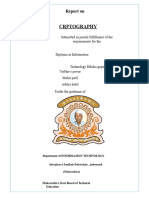0% found this document useful (0 votes)
24 views11 pagesCloud Security and Cryptography Basics
The document provides an overview of cloud security concepts, emphasizing the importance of protecting data, applications, and services in the cloud. It covers key elements such as data security, identity and access management, compliance, network security, and the shared responsibility model, along with best practices for maintaining security. Additionally, it delves into cryptography fundamentals, including conventional and public key cryptography, hash functions, authentication, and digital signatures, highlighting their roles in ensuring confidentiality, integrity, and authenticity in digital communications.
Uploaded by
k.rahini2005Copyright
© © All Rights Reserved
We take content rights seriously. If you suspect this is your content, claim it here.
Available Formats
Download as DOCX, PDF, TXT or read online on Scribd
0% found this document useful (0 votes)
24 views11 pagesCloud Security and Cryptography Basics
The document provides an overview of cloud security concepts, emphasizing the importance of protecting data, applications, and services in the cloud. It covers key elements such as data security, identity and access management, compliance, network security, and the shared responsibility model, along with best practices for maintaining security. Additionally, it delves into cryptography fundamentals, including conventional and public key cryptography, hash functions, authentication, and digital signatures, highlighting their roles in ensuring confidentiality, integrity, and authenticity in digital communications.
Uploaded by
k.rahini2005Copyright
© © All Rights Reserved
We take content rights seriously. If you suspect this is your content, claim it here.
Available Formats
Download as DOCX, PDF, TXT or read online on Scribd
/ 11






























































































